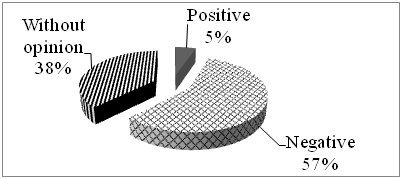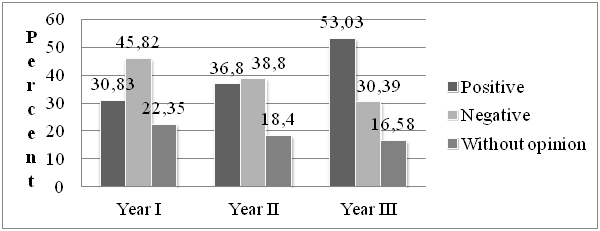Introduction
The issue of concubinage takes a significant place in modern demographic policy. The transition from legally regulated marriage to cohabitation began around 1965 in the US, but by 1975 this trend disappears [1,2,3]. This process continues today in Western Europe, and it is particularly strong in Denmark, France, Netherlands, Sweden [4,5,6].
The results of the population censuses in our country, conducted in the period 1965-2011, show that unformed partnerships between the two genders are a fact [7, page 2-3]. The study conducted by D. Vassilev in 1975 proved that cohabitations in this period are for the most part temporary premarital relations, playing the role of trial marriages [8, pp. 34-38]. In 1977, Popova defended her dissertation «Medico-social aspects of illegitimate births» [9, p. 211]. The census in 1985 recorded that 8.6% of female population live in concubinage [10, pp. 78-89]. In 1987 and 1988 two sociological polls were conducted aiming to study public opinion about legally unformed cohabitations [11, рр. 77-84].
Destabilization of marriage in the past two decades is deepening. Striking fact about this is that in 1999 half of the marriageable population in the country never married [12,13]. Twenty-two percent of respondents of international research «Fertility and Family» conducted in 1999 indicated that «… marriage is an outdated institution» [13,14,15].
According to data of the Central Statistical Office in 2007, over 60% of the population in the age over 30 years have no legal marriage [14, p. 122]. The number of marriages continued to decrease in 2012. Registered legal marriages are 281 less than the previous year [https://www.nsi.bg/]. The trend of absolute and relative increase in illegitimate births continues. At the beginning of XX century it is 0.42 %, during 1941-1945 it is 2.90 %, during 1961-1965 it is 8.50 %. For the period 1998-2007, the number of illegitimate live births increased almost two-fold and in 2007 it is 50.20% of all births [7,9,14,15,16,17,18].
At the beginning of this century M. Sugareva [19, pp. 142-158]questions the need for a modern family policy, and the National Strategy for demographic development of our country deals with issues related to cohabitation as one of the risk factors leading to one-child family model [20, p. 59].
Materials and Methods
One of the main tasks of the study «Sexual culture, sexual behavior and family planning of students from Medical College — Plovdiv» held in 2007 was to reveal the attitude of future medical officers to marriage as a basic social institution. An anonymous questionnaire was used in the study. 435 students from all the eight specialities of Plovdiv Medical College were questioned. An alternative, non-parametric and graphic analyses were used in the statistical processing.
Results
The participants in the study were asked the question «Is official marriage necessary in modern society?»
An impressing fact is that the shares of those who accept non-marital cohabitation and those who do not is approximately equal — 44,03 ± 2,48% in the first against 38,56 ± 2,43 in the second [see Diagram 1]. The comparison of our results with the studies of L.Spasovska, M. Sugareva and E. Kostova show that for a relatively short period of time the share of those who consider legal marriage is not necessary increased three times — from 15.5 % to 44.03% in our study [9,10,11,12,13].

Diagram 1. Distribution of the observed contingent depending on the attitude to legal regulated marriage
With increasing age increases the percentage of students who indicated the need for a legally regulated cohabitation [see Table 1]. The lowest share of respondents indicating the need for formal marriage is among respondents aged 20 years and the highest in those over 25 years. Statistical analysis allows to conclude that age has a significant impact on the respondents’ views on the issue of the future of the family as a basic social unit in the contemporary society Р< 0,01 [c2=11,35].
Table 1.
Attitute towards legally regulated marriage in modern society
depending on the students’ age
| Age,
years |
Do you consider legally regulated marriage necessary? |
Total |
|||||||||
| Yes, I do. | No, I do not. | I cannot judge. | |||||||||
| N | % | Sp | N | % | Sp | N | % | Sp | N | % | |
| < 20 | 20 | 29,85 | 5,56 | 32 | 47,76 | 6,06 | 15 | 22,39 | 5,02 | 67 | 100,00 |
| 20 – 24 | 131 | 45,81 | 2,95 | 106 | 37,06 | 2,85 | 49 | 17,13 | 2,22 | 286 | 100,00 |
| > 25 | 26 | 53,07 | 7,06 | 17 | 34,69 | 6,75 | 6 | 12,24 | 4,60 | 49 | 100,00 |
| Total | 177 | 44.03 | 2.48 | 155 | 38,56 | 2.43 | 70 | 17,41 | 1,87 | 402 | 100,00 |
A strong correlation exists between the age of the students and the course of training. This dependence was found when relationship between the need for juridical marriage and the year of training was sought – Р < 0,05 [c2=10,86].
The largest share indicated that legally regulated marriage is not necessary is registered in the first year students [see Diagram 2]. The percentage of respondents with same answer decreased by 15 points in the third year students. The trend is opposite in those supporting the need for real juridical marriage — 30,83 ± 3,07% of the first year students gave a positive response, while the share of students with the same response is almost 23% larger — 52 03 ± 7,70% among their colleagues from the third year. The difference is statistically significant — Р<0,01 [λ =2,68].

Diagram2. Attitute towards legally regulated marriage in modern society
depending on the students’ year of study
Students’ residence also has a statistically significant impact on their opinion on the need for juridical marriage — P <0,01 [λ = 1,82]. The share of students from the villages indicated that marriage is necessary is 33 points greater [see Table 2]. The difference in the percentages of students from the city and those from the villages who gave answer «Yes — it is necessary» is statistically significant at a level of 99,99% [λ = 5,54].
Table 2
Dependency of the opinion about legally regulated marriage on the residency
|
Residence |
Do you consider legally regulated marriage necessary? |
Total |
|||||||||
| Yes, I do. | No, I do not. | I cannot judge. | |||||||||
| N | % | Sp | N | % | Sp | N | % | Sp | N | % | |
| Town | 168 | 42,83 | 2,78 | 112 | 37,22 | 2,71 | 38 | 19,95 | 2,24 | 318 | 100,00 |
| Village | 58 | 74,36 | 4,97 | 12 | 15,38 | 4,04 | 8 | 10,26 | 3,40 | 78 | 100,00 |
| Total | 226 | 57,07 | 2,49 | 124 | 31,31 | 2,32 | 46 | 11,62 | 1,63 | 396 | 100,00 |
A particular interest is the disclosure of factors or rather the reasons forming the view that regulated legal marriage is not necessary in modern society. Only one third of the participants in the study answered the question — 34,89 ± 2,66%. Two are the leading motives of a purely material nature — lack of funds for a family and lack of own home [see Diagram 3]. These are two completely objective factors which are fully in line with the economic status of the Bulgarians. Thirdly stated is the desire for career and fourthly students indicate inadequate social demographic policy. Interesting is the motive that «children can be created without a legitimate marriage.»

Diagram 2 Motives leading to refusal of legally regulated marriage
Age is a factor that has a significant impact on the stated motives — F<0,001 [F=43,11]. More than half of the students from the youngest age group indicated the first two purely economic motives — lack of funds for a family and lack of housing. These motives are with 11 points less in the next age group and in the most senior group the difference is of 21 points. It is logical that with the increase of age the percentage of students stating career as a reason increases. So in the group over 25 years the share is 8% higher compared with the youngest students. Dynamically with increasing age relative shares in the motive » children can be created without a legitimate marriage» increase.
Factorial signs year of study and residence have no statistically expressible impact on the structure of the motives of the answers — P> 0,05.
Conclusions
- In the last few decades destabilization of marriage deepens in a global scale.
- In our country the percentage of people having negative attitude towards legally regulated marriage sharply increased for a short period of time.
- On the students’ negative attitude towards marriage statistically expressible influence have:
- Age of students
- Year of study
- Residence
- Major motives determinant for the negative attitude towards formal marriage are:
- Economic – lack of housing and lack of subsistence for creating a family;
- Professional realization;
- Inadequate social and demographic politics.
Reference
- Lindrooth RS et al. The effect of :edicaid Family Planning expansions on unplanned
Births Worn. Health, isswies, 2007,17 66-74 - Fertility and families in coutries of the ECE-region — Standart country report, Sweden.United National, NY, 1997, 78
- Patterns of fertility in low fertility Settings, United Nations, NY, 1992, 39p
- Cohabilitation and marriage transitional Pattern, Different type-style, Contraseption and Parenthood, 1998, 3-4,78-96
- Engle KL et al. The mass media are important context for adolescents sexual behavior. J.of Adolesent Health, 2006, 38, 186-192
- Спасовска Л. Тенденции в съжителството без брак в някои страни на Западна Европа и САЩ през 70-те и 80-те години. Население, 1993, 2, 61-70.
- Машиах А. Юридически неофициалните бракове в България, Социологически изследвания, 1968, 2-3.
- Василев Д. Медико-демографски рискове във формирането на семейството и възможностите им за медицинска профилактика. Население, 1987, 4, 34-38
- Попова С. Медико-социални аспекти на извънбрачната раждаемост. Дисертационен труд, С-я, 1977, 211.
- Сугарева М. Съжителствата — нова форма на семейството или криза на семейството. Население, 1992,3,78-89.
- Спасовска Л. Първи емпирични изследвания на безбрачните съжителства у нас. Население, 1995,3,77-84.
- Спасовска Л. Семейството в условията на дестабилизирането на брака у нас. Население, 1994,5-6,7-23.
- Жекова В. Развитие на браковете и брачността в България. Население, 2006, 3-4, 30-53.
- Население 2007, ЦСУ,2008,122 стр.
- Костова Д. Семейна форма и репродуктивна нагласа в България. Население, 2000,1,77-83.
- Минчева Е. „Събраха се … живеят заедно» Аспекти на семейството и брачността. Бълг.етнол., 2001,121-125.
- Жекова В. Тенденции в развитието на раждаемостта в България. Население, 2006, 2, 80-97.
- Костова Д. Влияние на семейния статус върху раждането на първо дете в България Фамилно съвместно съжителство и раждане на първо дете. Население, 2006, 3-4, 65-82.
- Сугарева М. Съвременната политика за семейството в Европа и България, Население, 2000, 3, 142-158
- Национална стратегия за демографско развитие на България, 2007-2020, 2006, 59[schema type=»book» name=»MARRIAGE — LEGALLY REGULATED OR NOT ACCORDING TO THE STUDENTS FROM MEDICAL COLLEGE PLOVDIV» author=»Taneva Daniela Ivova, Kirkova Angelina Georgieva, Baltov Marin Kostadinov» publisher=»БАСАРАНОВИЧ ЕКАТЕРИНА» pubdate=»2017-06-16″ edition=»ЕВРАЗИЙСКИЙ СОЮЗ УЧЕНЫХ_ 30.12.2014_12(09)» ebook=»yes» ]

